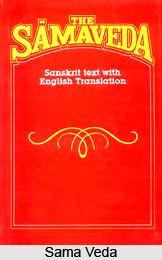 Brahmana of Sama Veda comprises various verses that are used for religious rites.
Brahmana of Sama Veda comprises various verses that are used for religious rites.
Panchavimsa Brahmana of Sama Veda
Panchavimsa Brahmana derives its name from the detail that it has 25 chapters. They are called Prapathakas which are subdivided into 347 sections called `khandas`. It is even known as the `Tandya Mahabrahmana`. It is the major Brahmana text of the Kauthuma and the Ranayaniya schools. It deals with the use of various verses in various Vedic rituals. The Soma sacrifices are also discussed in detail. It deals with Collection of Yajus, Vistutis, Various rites, Somaprayaschittas, Dvadashaha rite, One day rites, Ahina rites and the Sattras.
Shadavimsa Brahmana of Sama Veda
Shadavimsa Brahmana is an appendix to the Panchavimsa Brahmana. It deals with the Subrahmanya speeches and with one-day rites. It is a small text that consists of five sections.
Samavidhana Brahmana of Sama Veda
Samavidhana Brahmana consists of 3 prapathakas that deals with the recitation of verses in order to obtain specific results.
Arsheya Brahmana of Sama Veda
Arsheya Brahmana is a kind of an Arshanukramani that is connected with the Gramageya and Aranya Samans. It is possible that a particular verse might have more than one Sage associated with it.
This article is a stub. You can enrich by adding more information to it. Send your Write Up to content@indianetzone.com



















